Recapping the NZ emergency news
Thursday 31 December 2020
More from Vinny Eastowood on the possible January 15 lockdown
Two videos removed from You Tube in 24 hours
I wondered, when I posted it how long it would remain up. I have reposted it on Brighteon.
This is the second video that has been removed in the last 24 hours. The other was Dr. Wakefield's warning about the vaccine.
I shall continue to work around the censorship.
| Hi Sawmorerocks98, | |
| Our team has reviewed your content, and, unfortunately, we think it violates our Community Guidelines. We've removed the following content from YouTube: | |
| Video: UK hospitals | |
 | |
| We know that this might be disappointing, but it's important to us that YouTube is a safe place for all. If content breaks our rules, we remove it. If you think we've made a mistake, you can appeal and we’ll take another look. Keep reading for more details. | |
| How your content violated the policy | |
YouTube doesn’t allow content that explicitly disputes the efficacy of local health authorities’ or World Health Organization (WHO) guidance on social distancing and self isolation that may lead people to act against that guidance. Learn more here.
| |
| |
| How this affects your channel | |
| Your channel now has 1 strike. You won't be able to do things like upload, post, or live stream for 1 week. A second strike will prevent you from publishing content for 2 weeks. Three strikes in the same 90 day period will result in your channel being permanently removed from YouTube. | |
| What to do next | |
| 95% of creators who get 1 strike never get another one. We want that for you too, so please: | |
| |
| Sincerely, The YouTube Team |
How the Scientific Advisory Group for Emergencies (SAGE) creates FEAR in the British public
How SAGE and the UK media created fear in the British public
27 June, 2020
COVID-19 started registering with most of the British public around late February and early March. Many were concerned but not particularly afraid. Only weeks later people were terrified to leave their homes or go near other human beings. How did such a dramatic shift in public perception happen so quickly?
In early March 2020, The Scientific Advisory Group for Emergencies (SAGE) produced a document for the UK Government highlighting methods for rolling out new social distancing rules. There seemed to be some doubt as to whether the public would comply with the upcoming measures so SAGE outlined a methodology based on known psychological behavioural modification techniques.
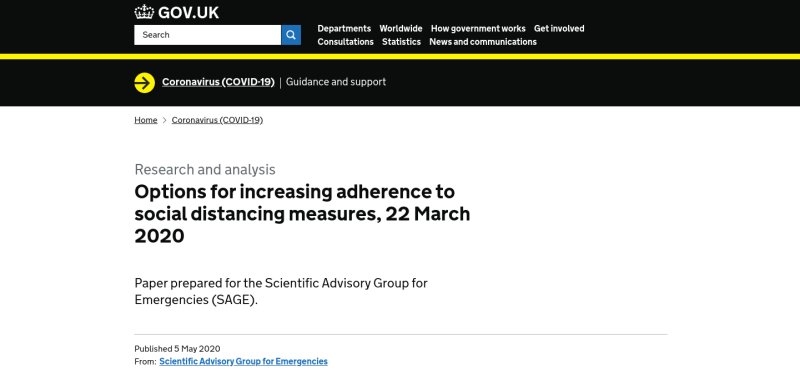
SAGE is an advisory group to the UK government responsible for making sure decision makers have access to scientific advice. We are told that the advice provided by SAGE does not represent official government policy.
SAGE also relies on expert sub-groups for COVID-19 specific advice. These sub-groups include:
- NERVTAG: New and Emerging Respiratory Virus Threats Advisory Group
- SPI-M: Scientific Pandemic Influenza Group on Modelling
- SPI-B: Independent Scientific Pandemic Influenza Group on Behaviours
The identity of individual committee members themselves were initially kept secret, purportedly due to national security. Some names were eventually released, largely due to efforts by UK businessman Simon Dolan and his legal challenge campaign. Nevertheless, two members remain anonymous.
Psychological techniques for behavioural change
The document itself, titled Options for increasing adherence to social distancing measures, was drafted by SPI-B, the behavioural science sub-group for SAGE.
SPI-B highlighted nine broad ways of achieving behavioural change in the public:
- Education
- Persuasion
- Incentivisation
- Coercion
- Enablement
- Training
- Restriction
- Environmental restructuring
- Modelling
In the document, SPI-B focused on the methods most relevant to their stated goals and set out ten options that were evaluated on six criteria.
The six criteria, under the acronym APEASE, were:
- Acceptability
- Practicability
- Effectiveness
- Affordability
- Spill-over effects
- Equity

Government persuasion through fear
A key part of SPI-B’s behavioural change strategy that seems to have been adopted was to ‘persuade through fear.’ The Persuasion section of the document states:
A substantial number of people still do not feel sufficiently personally threatened.
Clearly, the psychologists felt that, as of late March, the public was still not afraid of COVID-19. It therefore suggested that the government increase the level of fear:
The perceived level of personal threat needs to be increased among those who are complacent, using hard-hitting emotional messaging.
Appendix B of the document lists ten options that can be used to increase social distancing in the public. Option 2 advises:
Use media to increase sense of personal threat.
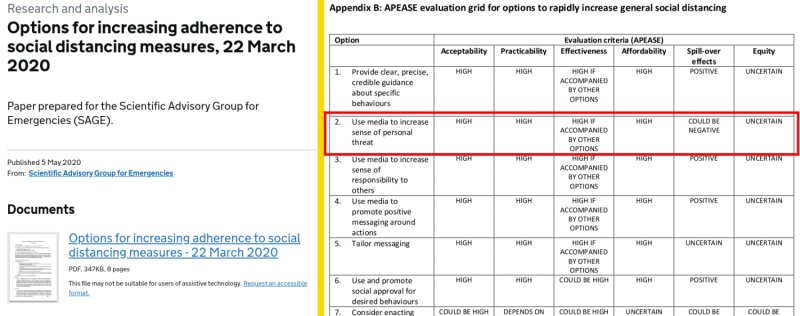
In hindsight, this explains the tone of government sponsored social media and physical billboard advertising campaigns that started appearing around April.
SPI-B recommendations to increase personal threat and use hard-hitting emotional messaging are on display with eerie imagery coupled with taglines such as:
- “Anyone can get it. Anyone can spread it.“
- “Don’t put your friends and family in danger.“
- “Stay home for your family. Don’t put their lives in danger.“
- “If you go out, you can spread it. People will die.“
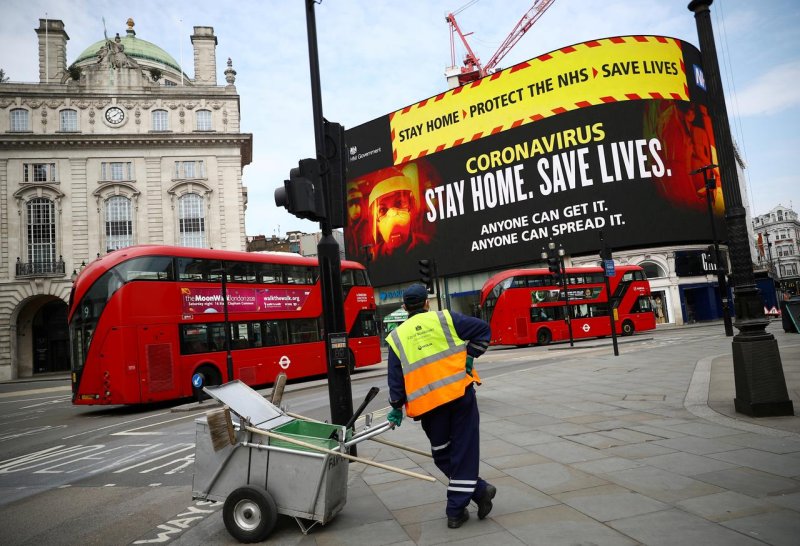

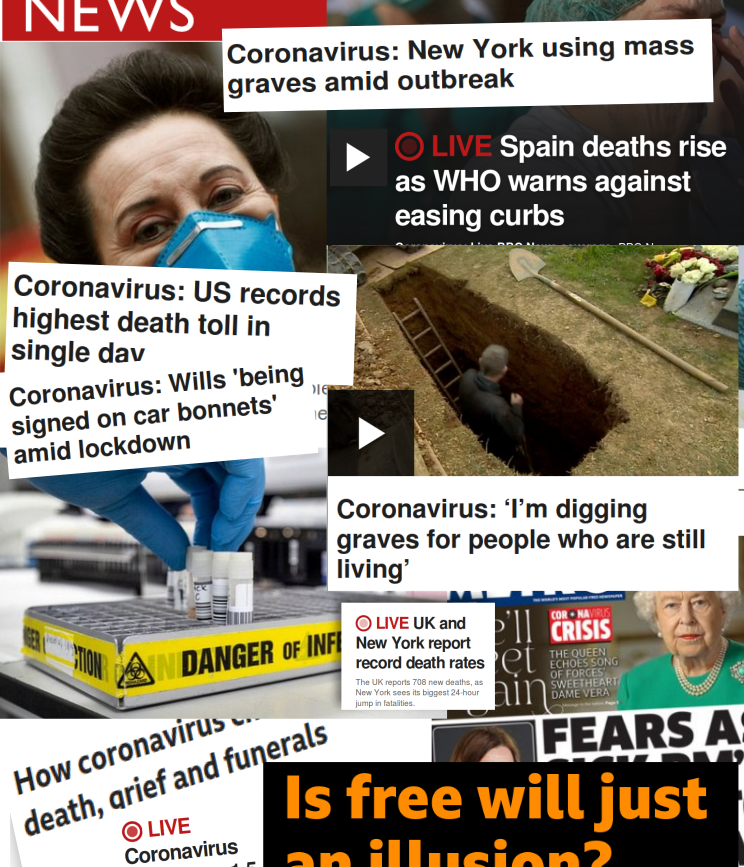
The article compared hysterical BBC news headline from the first week of April 2020 with those from 2018, when mortality rates were peaking due to a bad flu season. It found no references to flu or excess mortality on the BBC home page during the 2018 peak. InProportion2 asked, “Do the headlines reflect the gravity of the situations in an equivalent way – or is additional fear being stirred up in 2020?“
Persuasion through shame and approval: Covidiots and heroes
SPI-B psychologists knew that fear on its own would not persuade everyone. Messaging needed to be tailored to take into account different ‘motivational levers.’
Some people will be more persuaded by appeals to play by the rules, some by duty to the community, and some to personal risk.
It therefore suggested using both social approval and disapproval, with compulsion (legislation) as a backup:
- Option 6: Use and promote social approval for desired behaviours
- Option 7: Consider enacting legislation to compel required behaviours
- Option 8: Consider use of social disapproval for failure to comply
We can see the obvious approval-disapproval dialectic with the ‘Heroes and Covidiots’ narrative that soon began to surface in the news. The term ‘Covidiot’ appeared around March with The Economist’s 1843 Magazine describing covidiots in this way:
Even in a pandemic, many of us are prone to judge others and find them wanting: the term “covidiot” describes any and every person behaving stupidly or irresponsibly as the epidemic spreads. Sometime in early March the word was born, and, almost as fast as the virus spread, so did instances of covidiotic behaviour.
Although it’s not clear how the term came about, it was quickly adopted in UK mainstream and social media. At the same time, we began seeing praise for heroes who ‘did the right thing’ by complying with the government measures.
The METRO article below shows all three options in play:
- Social approval: “These local heroes have been doing amazing things…”
- Social disapproval: “Lake District closed…because covidiots won’t stay away…”
- Compulsion: “Matt Hancock threatens to close beaches…”
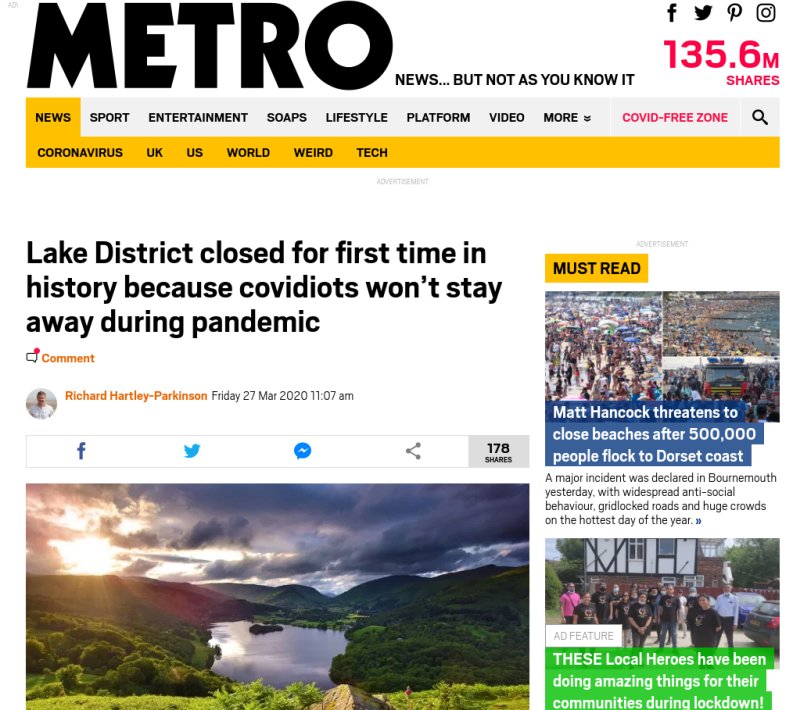
An incentivised media
These psychological techniques would have been impossible to deploy on the public without a compliant media. How did the government convince the media to go along with the plan?
Increased UK government media spending
Digiday, a media and marketing industry publication, reported in April that the government is becoming UK news publishers’ most important client. In the 20 April 2020 article for Digiday, Lara O’Reilly wrote:
…the government is spending more than usual, judging by their bookings. The publishers also pointed out that the lack of activity from other advertisers in the current market means the government campaigns will have an outweighed share of voice compared with normal times.
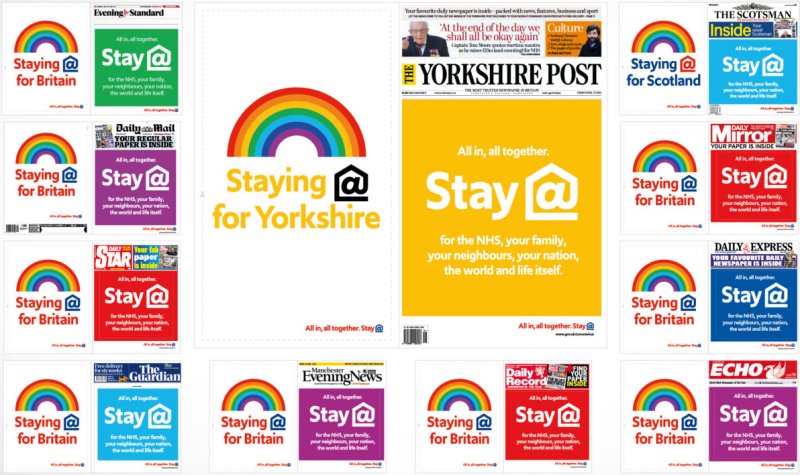
During that period, the British public started seeing coverage across media outlets with the unified “In this together” messaging. O’Reilly pointed out that the campaign was worth £35 million over a three month period.
Last week, the government and newspaper industry launched a three-month advertising partnership dubbed “All in, all together.” The campaign — worth approximately £35 million ($44 million) for the full course, according to sources — kicked off on Apr. 17, with all the U.K.’s national and regional daily news brands running near-identical cover wraps and homepage takeovers, which carried the copy, “Stay at home for the NHS, your family, your neighbours, your nation the world and life itself.”
So, we ask again: how did the government convince the media to go along with the plan? The answer is simple and obvious: with lots of money.
Psychological techniques to change behaviour
We can see that the UK Government has a public document outlining psychological techniques to change the behaviour of the population. We see a unified mass-media campaign that falls in line with these techniques. We then see a dramatic shift in public perception and behaviour.
What else can we call this but ‘brainwashing’?
Despite the open nature of what has transpired, it seems to have gained little coverage in the media. This is of no surprise since it was clearly complicit in spreading fear in the public.
Download the document
The document is freely downloadable on the gov.uk website in a page titled, “Research and analysis – Options for increasing adherence to social distancing measures, 22 March 2020“.
We encourage you to read the document, compare it with your observations about how the government and media has acted, then make up your own mind.
The tight connections between western media and the CCP
All Major Western Media Outlets Take "Private Dinners", "Sponsored Trips" From Chinese Communist Propaganda Front
A host of corporate media outlets including CNN, The New York Times, The Washington Post, and MSNBC have participated in private dinners and sponsored trips with the China-United States Exchange Foundation, a Chinese Communist Party-funded group seeking to garner “favorable coverage” and “disseminate positive messages” regarding China, The National Pulse can reveal.
30 December, 2020
Other outlets involved in the propaganda operation include Forbes, the Financial Times, Newsweek, Bloomberg, Reuters, ABC News, the Economist, the Wall Street Journal, AFP, TIME magazine, LA Times, The Hill, BBC, and The Atlantic.
The relationship is revealed in the Department of Justice’s Foreign Agent Registration Act (FARA) filings, which reveal a relationship spanning over a decade between establishment media outlets and the China–United States Exchange Foundation (CUSEF).
‘Neutralize Opposition.’
CUSEF is a Chinese Communist Party-funded initiative founded by Tung Chee Hwa. The group also targets American universities with offers to fund policy research, high-level dialogues, and exchange programs.
Tung also serves as Vice-Chairman of the Chinese People’s Political Consultative Conference (CPPCC), identified by the U.S.-China Security and Economic Review Commission as a key component of the Chinese Communist Party’s United Work Front.
The effort, according to the U.S. government report, aims to “to co-opt and neutralize sources of potential opposition to the policies and authority of its ruling Chinese Communist Party.”
“The United Front strategy uses a range of methods to influence overseas Chinese communities, foreign governments, and other actors to take actions or adopt positions supportive of Beijing’s preferred policies,” it continues.
This strategy appears to have been deployed in conjunction with outlets such as CNN, New York Times, and the Washington Post.
Targeting Reporters, Journalism Students.
A 2011 FARA filing highlighted by Axios detailed CUSEF’s agreement with American lobbying firm BLJ. It outlines how CUSEF set out to “effectively disseminate positive messages to the media, key influencers and opinion leaders, and the general public” regarding China.
To do so, CUSEF targeted working journalists and journalist students:
In order to develop favorable coverage in key national media, BLJ will continue to organize and staff “familiarization trips” to China. This includes recruiting top journalists to travel to China, selected for effectiveness and opportunities for favorable coverage.
In 2009 alone, CUSEF generated 28 media placements as a result of its four journalist visits and BLJ secured “the publication of 26 opinion articles and quotes within 103 separate articles” on behalf of CUSEF.
Outlets included Newsweek, the National Journal, the Nation, Congressional Quarterly, U.S. News, World Report, The Chicago Tribune, and the Washington Note.

“BLJ directly contributed to or influenced” an average of three articles “per week.”
Guilty.
While universities, including the University of Texas at Austin, have divested from CUSEF in light of its Chinese Communist Party ties, the same cannot be said for dozens of Western media outlets.
FARA filings from CUSEF’s American lobbying firm BLJ reveal American media organization participating in “private dinners at BLJ’s CEO’s home on behalf of CUSEF,” trips to China, and meetings with CUSEF officials.
A filing dated January 1st, 2012, show outlets including The New York Times, The Wall Street Journal, Reuters, CNN, and more participating in “private dinners” at the home of CUSEF’s American lobbying firm’s CEO.

The same filing reveals that outlets including National Public Radio (NPR), The Atlantic, MSNBC, and Reuters had journalists visit China to meet with CUSEF officials.
Since then, filings continue to reveal a host of Western outlets attending private dinners and visiting China. Most outlets are included more than once.
In 2013, The Washington Post joined a China-bound journalism delegation, in 2014 Harvard Business Review also joined a delegation, and in 2015, the Los Angeles Times and The Huffington Post also visited the communist country.
A 2014 filing reveals that lobbying firm BLJ “arranged private dinners in New York and Washington DC on behalf of CUSEF” with over 20 attendees including The New York Times, The Washington Post, Reuters, Associated Press, BBC, and more:

Images in CUSEF brochures shed light on the entities visited by journalists.
Between 2011 and 2013 images reveal journalist touring Huawei – a telecommunications firm labeled a “national security threat” and military collaborator by the U.S. government – along with Chinese military bases:


Results.
Following the ongoing pressure campaigns, CUSEF has escaped significant criticism in the corporate press. There have only been a few mentions in broader pieces concerning Chinese Communist Party influence operations on American college campuses.
Such behavior from news outlets implies a conflict of interest, or worse: that the ostensible news outlets have been bought off.
Even when CUSEF is criticized, such as in The Washington Post article “China’s reach into U.S. campuses,” CUSEF’s Executive Director Alan Wong was offered a rebuttal: something that even Americans on the political right fail to obtain from outlets such as the Post.
Vox, another outlet participating in CUSEF’s journalism trips, prefaced an article on President Trump and North Korea by noting author Yochi Dreazen “wrote it while on a trip to China sponsored by the China-United States Exchange Foundation (CUSEF)”:
The author of this article wrote it while on a trip to China sponsored by the China-United States Exchange Foundation (CUSEF), a privately funded nonprofit organization based in Hong Kong that is dedicated to “facilitating open and constructive exchange among policy-makers, business leaders, academics, think-tanks, cultural figures, and educators from the United States and China.” Vox.com’s reporting, as always, is independent.
The article, which featured quotes from Chinese Communist Party officials, appeared to regurgitate the party line, noting “Beijing won big.”
As Foreign Policy magazine noted, to its credit, CUSEF is scarcely a privately funded non profit but rather is “a registered foreign agent bankrolled by a high-ranking Chinese government official with close ties to a sprawling Chinese Communist Party apparatus that handles influence operations abroad.”





